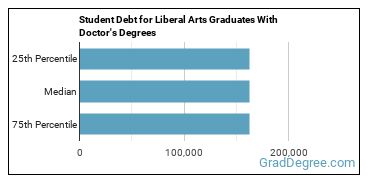Doctor’s Degrees in Liberal Arts General Studies
Featured schools near , edit
Education Levels of Liberal Arts Majors
During the most recent year for which data is available, 108 people earned their doctor's degree in liberal arts. This makes it the 123rd most popular doctor's degree program in the country.
The following table shows the number of diplomas awarded in liberal arts at each degree level.
| Education Level | Number of Grads |
|---|---|
| Master’s Degree | 1,863 |
| Graduate Certificate | 347 |
| Doctor’s Degree | 108 |
Earnings of Liberal Arts Majors With Doctor’s Degrees
At this time, we do not have the data to estimate the median earnings for this class of people.
Student Debt
The median student debt for graduates holding a doctor's degree in liberal arts is $190,629. The school you go to and how long it takes you to graduate, among other things, can cause this number to vary. The chart below shows the range of accumulated debt loads. On the high side of the range, $190,629 is the debt load, and the debt load on the low side is $190,629.

Student Diversity
More women than men pursue their doctor's degree in liberal arts. About 63.0% of graduates with this degree are female.
| Gender | Number of Grads |
|---|---|
| Men | 40 |
| Women | 68 |

The racial-ethnic distribution of liberal arts doctor’s degree students is as follows:
| Race/Ethnicity | Number of Grads |
|---|---|
| Asian | 4 |
| Black or African American | 12 |
| Hispanic or Latino | 9 |
| White | 67 |
| International Students | 7 |
| Other Races/Ethnicities | 9 |

Most Popular Liberal Arts Programs for Doctor’s Degrees
There are 29 colleges that offer a doctor’s degree in liberal arts. Learn more about the most popular 20 below:
The most popular school in the United States for liberal arts students seekinga doctor's degree is The University of Texas at Dallas. Each year, around 28,600 students seeking various degrees attend the university. The average in-state tuition for full-time undergraduates is $14,564 per year, while in-state graduate students, on average, pay $15,088 per year. During the most recent year for which we have data, 13 people received their doctor's degree in liberal arts from UT Dallas. Around 38% of these students were from an underrepresented racial-ethnic group, and 69% were women.
The 2nd most popular school in the country for liberal arts majors who are seeking their doctor's degree is Clark Atlanta University. Roughly 3,700 attend the school each year. The average in-state tuition for full-time undergraduates is $21,948 per year, while in-state graduate students, on average, pay $17,118 per year. During the most recent year for which we have data, 11 people received their doctor's degree in liberal arts from CAU. Of these students, 33% were women and 67% were members of underrepresented racial-ethnic groups.
The 3rd most popular school in the country for liberal arts majors who are seeking their doctor's degree is University of Maryland - Baltimore County. Roughly 13,400 attend the school each year. The average in-state tuition for full-time undergraduates is $9,056 per year, while in-state graduate students, on average, pay $12,582 per year. During the most recent year for which we have data, 10 people received their doctor's degree in liberal arts from UMBC. Of these students, 89% were women and 56% were members of underrepresented racial-ethnic groups.
Southern Methodist University comes in at #4 on our list of the most popular colleges offering doctor's degrees in liberal arts. Each year, around 12,300 students seeking various degrees attend the university. The average in-state tuition for full-time undergraduates is $55,012 per year, while in-state graduate students, on average, pay $31,590 per year. During the most recent year for which we have data, 9 people received their doctor's degree in liberal arts from SMU. Of these students, 75% were women and 13% were members of underrepresented racial-ethnic groups.
The 5th most popular school in the country for liberal arts majors who are seeking their doctor's degree is Pacifica Graduate Institute. Each year, around 800 students seeking various degrees attend the university. During the most recent year for which we have data, 7 people received their doctor's degree in liberal arts from Pacifica Graduate Institute. About 67% of this group were women, and 20% were students from an underrepresented racial-ethnic group.
The 6th most popular school in the country for liberal arts majors who are seeking their doctor's degree is Georgetown University. Each year, around 19,300 students seeking various degrees attend the university. The average in-state tuition for full-time undergraduates is $61,872 per year, while in-state graduate students, on average, pay $56,592 per year. During the most recent year for which we have data, 6 people received their doctor's degree in liberal arts from Georgetown. About 33% of this group were women, and 11% were students from an underrepresented racial-ethnic group.
Salve Regina University is the 7th most popular school in the nation for students seeking a doctor's degree in liberal arts. Each year, around 2,700 students seeking various degrees attend the university. The average in-state tuition for full-time undergraduates is $45,250 per year, while in-state graduate students, on average, pay $12,060 per year. During the most recent year for which we have data, 5 people received their doctor's degree in liberal arts from Salve Regina. Around 10% of these students were from an underrepresented racial-ethnic group, and 70% were women.
George Mason University is the 7th most popular school in the nation for students seeking a doctor's degree in liberal arts. The average in-state tuition for full-time undergraduates is $9,795 per year, while in-state graduate students, on average, pay $13,426 per year. During the most recent year for which we have data, 5 people received their doctor's degree in liberal arts from GMU.
Montana State University comes in at #10 on our list of the most popular colleges offering doctor's degrees in liberal arts. Roughly 16,200 attend the school each year. The average in-state tuition for full-time undergraduates is $5,824 per year, while in-state graduate students, on average, pay $5,241 per year. During the most recent year for which we have data, 4 people received their doctor's degree in liberal arts from MSU Bozeman.
Institute for Doctoral Studies in the Visual Arts comes in at #11 on our list of the most popular colleges offering doctor's degrees in liberal arts. Each year, around 0 students seeking various degrees attend the university. During the most recent year for which we have data, 3 people received their doctor's degree in liberal arts from IDSVA. Around 36% of these students were from an underrepresented racial-ethnic group, and 91% were women.
The 13th most popular school in the country for liberal arts majors who are seeking their doctor's degree is Johns Hopkins University. The average in-state tuition for full-time undergraduates is $60,480 per year, while in-state graduate students, on average, pay $60,480 per year. During the most recent year for which we have data, 2 people received their doctor's degree in liberal arts from Johns Hopkins.
New Mexico State University - Main Campus is the 13th most popular school in the nation for students seeking a doctor's degree in liberal arts. Each year, around 14,200 students seeking various degrees attend the university. The average in-state tuition for full-time undergraduates is $6,283 per year, while in-state graduate students, on average, pay $5,184 per year. During the most recent year for which we have data, 2 people received their doctor's degree in liberal arts from NMSU Main Campus.
The 16th most popular school in the country for liberal arts majors who are seeking their doctor's degree is University of Louisville. Each year, around 22,200 students seeking various degrees attend the university. The average in-state tuition for full-time undergraduates is $12,324 per year, while in-state graduate students, on average, pay $13,944 per year. During the most recent year for which we have data, 1 people received their doctor's degree in liberal arts from UofL.
The 16th most popular school in the country for liberal arts majors who are seeking their doctor's degree is Tulane University of Louisiana. The average in-state tuition for full-time undergraduates is $58,666 per year, while in-state graduate students, on average, pay $61,066 per year. During the most recent year for which we have data, 1 people received their doctor's degree in liberal arts from Tulane.
The 16th most popular school in the country for liberal arts majors who are seeking their doctor's degree is Ohio State University - Main Campus. Each year, around 61,300 students seeking various degrees attend the university. The average in-state tuition for full-time undergraduates is $11,525 per year, while in-state graduate students, on average, pay $12,092 per year. During the most recent year for which we have data, 1 people received their doctor's degree in liberal arts from Ohio State. Around 75% of these students were from an underrepresented racial-ethnic group, and 75% were women.
Liberal Arts Focus Areas
| Major | Annual Degrees Awarded |
|---|---|
| 70 | |
| 23 | |
| 13 | |
| 2 |
Explore Major by State
Alabama
Arkansas
Connecticut
Florida
Idaho
Iowa
Louisiana
Massachusetts
Mississippi
Nebraska
New Jersey
North Carolina
Oklahoma
Rhode Island
Tennessee
Vermont
West Virginia
References
*The racial-ethnic minority student count is calculated by taking the total number of students and subtracting white students, international students, and students whose race/ethnicity was unknown. This number is then divided by the total number of students at the school to obtain the percentage of racial-ethnic minorities.
More about our data sources and methodologies.
Featured Schools
 Request Info
Request Info
|
Southern New Hampshire University You have goals. Southern New Hampshire University can help you get there. Whether you need a bachelor's degree to get into a career or want a master's degree to move up in your current career, SNHU has an online program for you. Find your degree from over 200 online programs. Learn More > |












